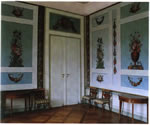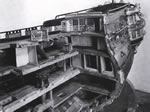|
158 Lee Avenue ph: +1 416-691-2516 info @ archimuse.com Join
our Mailing
List.
published: March 2004 |

Expanding the Story Line
Peter Hoffmann, University of Luebeck, Institute for Multimedia and Interactive Systems, Germany
Abstract
It is not easy to describe the possibilities of digital or virtual storytelling with the standard vocabulary. So this article has two goals. First, it will try to define a better image and a more correct vocabulary for describing the field of virtual storytelling. Secondly, it presents a narrative system called Jeherazade, using the aforementioned concepts and ideas. A practical implementation of Jeherazade system at the Eutin castle in Germany is presented.
Keywords: digital storytelling, virtual storytelling, narrative system, Jeherazade
Introduction
The new form of digital or virtual storytelling follows the same well known strategies similar to classical storytelling. The one most frequently used is the one which follows the course of suspense in a poetic story as Aristotle described it long ago. Following his ideas and theories, most narratives are divided in the following four phases (Staehle, 1973; Fuhrmann, 1992):
- Exposition: In the exposition period the characters and their environment are introduced. The audience is introduced to a problem, which is the basis for the further story line.
- Ascension: Introducing and intensifying conflicts increase the suspense of the story. These conflicts can arise either from ideological differences or if the characters have different levels of knowledge.
- Climax: The climax in the story occurs at that point in time when the main character makes a decisive step towards solving the problem.
- Conclusion: In the final period of the story still-open conflicts are resolved. The audience returns to the same level of suspense as the beginning of the story.
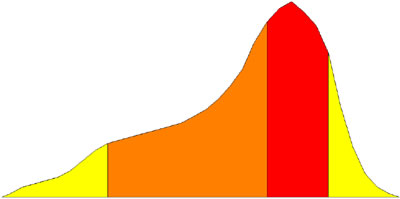
Figure 1 – The well-known course of suspense of Aristotle with the four phases: exposition, ascension, climax, conclusion
The person reading or experiencing the story follows one story line path. The only possible types of interaction for them are to go ahead, to go back, or leave the narrative.
Expanding the Story Line
Digital storytelling offers another dimension which is not available to classical storytelling. A freedom of movement and a wider range of decisions is available in digital storytelling (Heintze, 2000). The new kind of narrative offer the reader different narrative paths: the two dimensional story line does not longer exist in this method. It is expanded with at least one more dimension so that it can no longer be called a (story) line. It is more precise to call the story told using digital storytelling method a "story site".
The reader has the possibility to choose their own way to one possible end of the narrative. Their role as a reader now evolves from a passive to an active role. They are free to move within the narrative to explore and experience their own individual "story path". The reader has become a "story chaser".

Figure 2 - Expanding the storyline: the story site
The author can design story in different ways. One of them is to create additional "story tracks" which run parallel to a main "story track" (see Figure 2). The main story track corresponds in its course of suspense with the classical story line. If the story chaser follows the main story track exclusively, they experience the most interesting and suspenseful story track of the narrative. Each of the other tracks are similar to the main track; they only present a less suspenseful narration. The farther the tracks are from the main story track, the less exciting is their story. It does not matter which story track the story chaser chooses; they always will experience a course of suspense with their own individual highlight (climax) (see Figure 7).
Another way of designing the story site is to divide the story site grid in areas with different suspense. The region and position of the climax in the story site grid is determined whether the story line development is linear (see Figure 3) or non-linear (see Figure 4). The areas are outside of the climax region less suspenseful. The farther the areas are from the center, the less suspenseful they are.
This kind of story design has the disadvantage that it may be possible for the story chaser to travel a story path without any change in the level of suspense. In the worst case the story path can even be without any kind of highlight. Such a story path is of course boring and gives no real experience or motivation. It is one of the tasks of the storyteller to prevent that using hints and clues as to which track is the best choice at the next node.
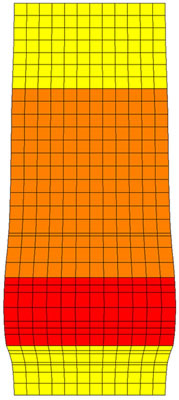
Figure 3 – Story site grid with linear development

Figure 4 - Story site grid with non-linear development
The Jeherazade Storytelling System
The Jeherazade system is an interactive digital storytelling system. This system is based on the idea that the story chaser experiences a narrative by choosing an individual story path in a story site, thus adopting an active role in the narrative. The story chaser plays a character in the story who is inquisitive and poses questions (e.g. Agatha Christie type character).
The other characters in the narration are the actors that present the narrative’s content. Such characters can be personalized ones like avatars but also abstract ones like video players or text-based windows.
The story chaser chooses to interact with an individual story path in the story site. For the interaction the story chaser uses the offered equipment. This equipment includes all devices which are necessary for any kind of input to Jeherazade. The equipment is used by the story chaser to interact with the characters and the story site.
The story site is designed by the author with a tag-based modeling language. This modeling language enables the author to design the story site by using story tracks as well as story areas.
The very first part of the designed narrative is the definition and preparation of all characters and all pieces of equipment which are going to appear in the narrative. First, the function and default adjustments of each character and every piece of equipment is determined.
The story points (i.e. decision nodes) are the least part of each Jeherazade story. Each of those points is defined separately in the "flow" part of the narratives description. The description consists of the following:
- adjusting the appearance of characters
- adjusting the behavior of characters
- "feeding" the characters with information and content they will present
- adjusting the appearance of the equipment
- linking characters and equipment
- linking the equipment with (possible next) story points
|
Figure 5 – Simplified architecture of Jeherazade |
Figure 6 – Example for using the modeling language of Jeherazade |
The core of the story site is the Jeherazade system (see: Figure 5). Jeherazade manages the complete knowledge and information about the narrative content, the story chaser’s present position, and their chosen path. Depending on the story chaser’s position and input, Jeherazade determines what information the characters are to present and it adjusts characters’ appearance and behavior accordingly. Jeherazade also chooses which story points would best fit the further course of suspense.

Figure 7 – Example for a story path in a story site
Implementation
The concept of Jeherazade was originally developed for presentations in museums. The first version of Jeherazade is being tested at the moment (Date: January 2004). The first practical demonstration, mediapark, is a story site of the multimedia campus in Luebeck and the Institute for Multimedia and Interactive Systems (IMIS) (Hoffmann & Herczeg, 2004). In this demonstration, 2D comic characters guide the story chaser through the story site
The goals of the mediapark presentation are:
- Proof of feasibility of the Jeherazade concept
- Modeling characters
- Modeling equipment
- Testing authoring tools for the authors
Background and Presentation of the Eutin Castle
The Jeherazade system will be used is an installation in the Eutin castle in northern Germany. The goal there is to present the visitors the history of the chateau; including the various alterations and restorations in its architecture and the use of several of its chambers. The presentation also relates various antidotes of prominent figures connected to the chateau (Schulze 1991).
The Lutheran bishops of the family Gottorf received the sovereign rights for the city of Eutin and the surrounding villages by the German emperor. They founded the castle in Eutin, which became the regent of many members of their family.
|
Figure 8 – Duke Adolf von Gottorf (1526 – 1586) |
Figure 9 – Sovereign Bishop Hans Duke von Gottorf (1606 – 1655) |
Figure 10 – Sovereign Bishop Friedrich Duke von Holstein-Gottorf (1646 - 1705) |
The castle was build in various stages. In the beginning it was build as a mediaeval fort (see: Figure 11). In the middle of the 17th century it was converted to a castle, whose style can still be recognized today (see Figures12 & 13).
|
Figure 11 – Early castle Eutin (1586) |
Figure 12 – View on the chateau from the west (1717) |
|
Renovation and restoration since 1988, the Eutin castle opened in 1997 as a museum to the public. Parts of the exhibition with the main theme of the regions history are historical ceiling paintings, wall tapestries, antique chattels and the collection of ship models of Char Peter the Great (see: Figures 11, 15, 16).
|
Figure 14 –Kings chamber or yellow salon |
Figure 15 – Room with flower tapestry in the western wing |
Figure 16 – Shipmodel from the collection of Char Peter the Great |
The historical and anecdotal information of the castle is divided into story segments, which in their entirety creates the story site of the presentation. Visitors can navigate freely through the story site and they determine their own individual paths. This focal purpose of the presentation is to determine the interests (e.g. historical or architectural) and adapt the presentation, or story line, accordingly.
The prototype of the Jeherazade Eutin castle presentation has been completed (Hoffmann & Herczeg, 2004). The interaction as well as the free navigation through the demonstration narrative works well.
Future Prospects
The final technical realization of the Jeherazade system for Eutin castle must be completed. It will be necessary to provide the writers or developers of Jeherazade presentations with easily accessible and comprehensible authoring tools. The first tests with XMendel, a web-based semantic Web tool (Hartwig & Herczeg & Hadley, 2003; Hartwig & Herczeg, 2003) developed in the Institute for Multimedia and Interactive Systems (IMIS) in Luebeck, were positive. It will be used to design the final Eutin presentation.
It is intended to use the Jeherazade system as a combined narrative and navigating system for exhibitions in spacious areas like extended archaeological sites (Hoffmann & Herczeg, 2003).
References
Adams, Ernest (1999). Three problems for interactive storytellers. 1999. Consulted December 20, 2003. http://www.gamasutra.com
Dean, David (1996). Museum Exhibition: Theory and Practice. London: Routledge.
Fuhrmann, Manfred (1992): Die Dichtungstheorie der Antike. Darmstadt: Wissenschaftliche Buchgesellschaft.
Hartwig, R. & M.Herczeg & L. Hadley (2003). XMendeL - A web-based semantic Web Tool for e-Learning Production Processes. In Proceedings to ICCE 2003. Hong Kong: International Conference on Computers in Education. 556-563
Hartwig, R. & M. Herczeg (2003). A Process Repository for the Development of E-Learning Applications. In Proceedings to ICALT'03. Athens, Greece: The 3rd IEEE International Conference on Advanced Learning Technologies. pp.346-347
Heintze, Jobst von (2000). Emergent Stories – eine neue Herangehensweise zum Erleben und zum Authoring interaktiver Geschichten. In U. Spierling (Hrsg.) Digital Storytelling, Tagungsband. Stuttgart: Frauenhofer IRB Verlag Stuttgart. 29 - 35
Hoffmann, P. & M. Herczeg (2004). Mediapark – Presenting the Mediadocks Luebeck with the Storytelling System Jeherazade. In S. Göbel (Hrsg.) Technologies for Interactive Digital Storytelling and Entertainment 2004. (Hrsg.). Stuttgart: Frauenhofer IRB Verlag Stuttgart. (to appear)
Hoffmann, P. & M. Herczeg (2003). Distributed Storytelling for Narrative in Spacious Areas. In S. Göbel & N. Braun & U. Spierling & J. Dechau & H. Diener (Hrsg.) Technologies for Interactive Digital Storytelling and Entertainment 2003. (Hrsg.). Stuttgart: Frauenhofer IRB Verlag Stuttgart. 346 - 350
Hooper-Greenhill, Eilean (1994). Museums and their visitors. London: Routledge.
Schön, I.; P. Hoffmann, M. Herczeg (2003) The Combination of Instructional and Narrative Models for e-Learning. In S. Göbel & N. Braun & U. Spierling & J. Dechau & H. Diener (Hrsg.) Technologies for Interactive Digital Storytelling and Entertainment 2003. (Hrsg.). Stuttgart: Frauenhofer IRB Verlag Stuttgart. 176 - 186
Schulze, H. K. L. (1991). Schloß Eutin. Eutin: Struve’s Buchdruckerei und Verlag.
Staehle, U. (1973). Theorie des Dramas.Ditzingen: Reclam.

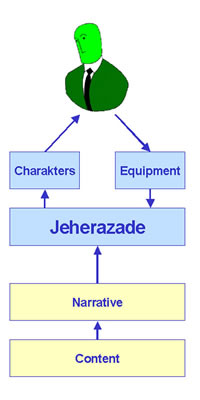

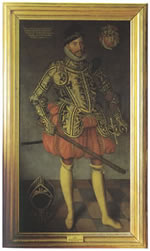
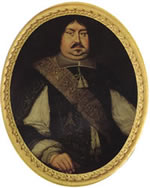
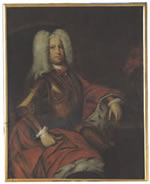

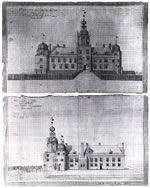
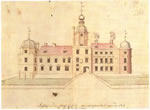 View of the chateau court
from the west (1959)
View of the chateau court
from the west (1959)
